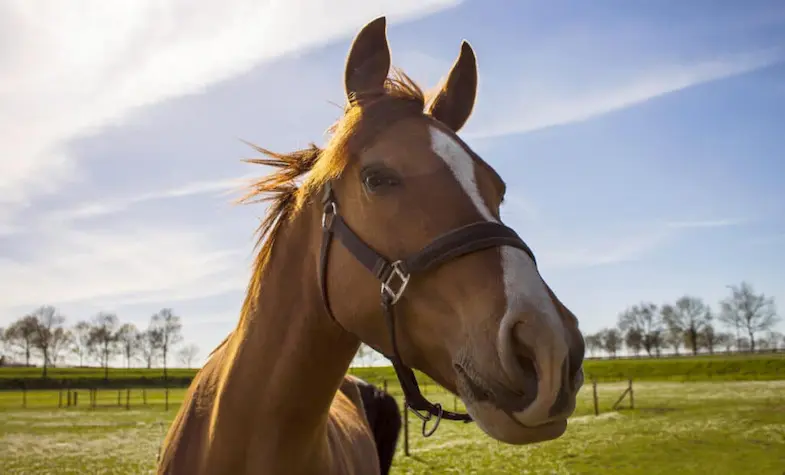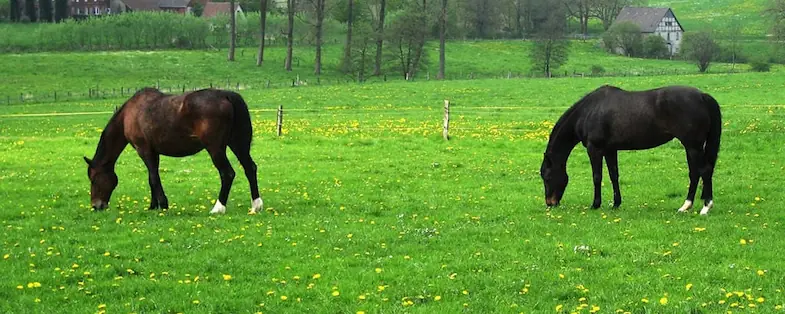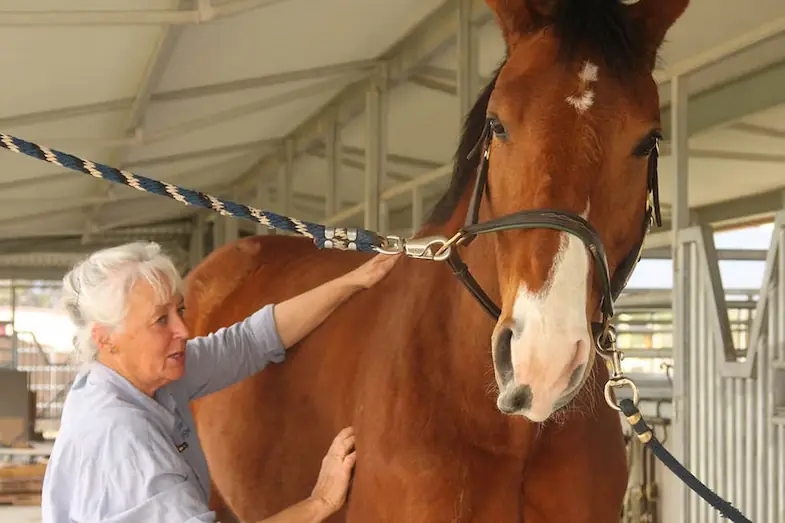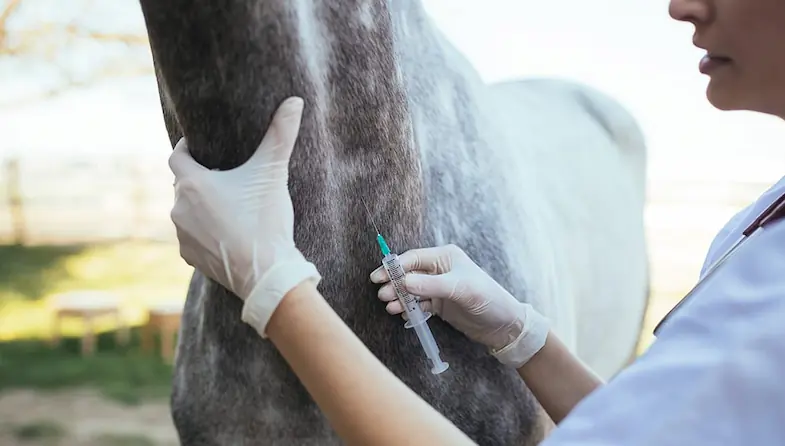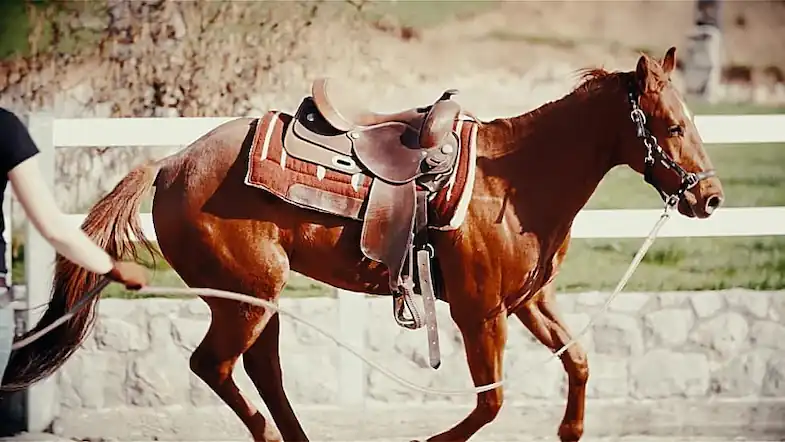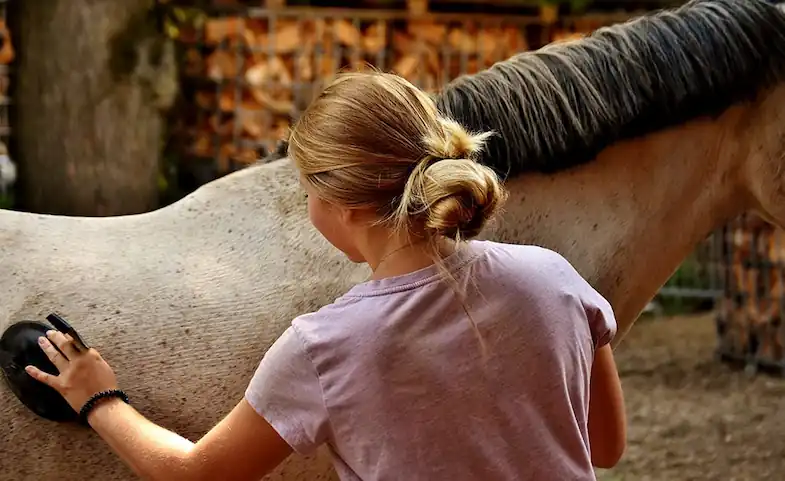The days are getting longer, the sun warmer, and the grass is starting to look lush. Spring is on your doorstep. With spring in the air, you and your horse will be looking forward to enjoying the outdoors. However, there are a few housekeeping items and preparation that you probably need to do to ensure that you and your horse are ready for spring.
Preparing yourself and your horse for spring will help ensure you both fully enjoy the warmer months and avoid unnecessary downtime. Many horses get time off in the winter, with limited turnout and exercise. Spring means increased exercise and more opportunities to participate in equestrian events. Here are some helpful tips to ensure that you and your horse are properly prepared for spring.
Prepare your outdoor arena
If you have an outdoor arena to ride in, it will need some preparation after the winter. Frozen ground and winter rains and snow can damage the surface. A good riding surface is important, as it reduces the risk of injury to your horse, and even you, if you’re unlucky to fall off. Start by collecting any debris that could have landed in the arena over the winter and pick up any stones. Once that’s done, harrow the surface to remove and ruts and even out the sand. Ruts and an unlevel surface increase your horse’s risk of a potentially serious tendon or ligament injury.
Clean up your paddocks
Before turning your horse out for the first time, carry out essential paddock maintenance. Start by walking your fence line, checking that nothing is weak or broken, and make any necessary repairs. Roll the field to remove ruts that could injure an excited, running horse. Check for holes that your horse could step in.
Fertilize and spread grass seed, making sure both are appropriate for horses. Take note of the amount of time you need to keep your horse off the grass. Depending on what fertilizer you use, the safe amount of time will differ.
Check all water troughs to make sure there are no leaks and that they are filling properly if they are automatic. Give the troughs a thorough scrub with a stiff brush and rinse out any gunk that’s built up over the winter. Remember, don’t use any harsh or unsafe chemicals to clean your troughs.
If you have electric fencing, this will need to be tested. Using a tester, check the entire fence line to ensure it is working. Look for any loose connections, stray wire, or tape that your horse could injure himself on.
Gradually increase turnout time
Spring grass is lush and full of goodness for your horse. However, it is also rich and high in sugars. Too much spring grass, especially too fast, can trigger laminitis. It can also cause too much weight gain, particularly in an easy keeper. Gradually introduce turnout by limiting time to a couple of hours and increasing this over a few weeks.
Get your trailer in order
Your horse trailer has likely been sitting idle during the winter. Before taking your horse out on a spring adventure, book them in for a service. Check that all your lights are working and there are no loose connections. Have a horse transport expert thoroughly inspect your trailer. Make sure that panels and the flooring don’t have any rot or need replacing. Ensure that all latches are secure. Importantly, make sure the tires and brakes are still working well. Finally, after the service, give your trailer a good wash and disinfect the interior.
Arrange a physiotherapist visit
Book a date for your horse with an equine physio before he starts back to work. The physio will tell you of any muscle issues that have cropped up over the winter. They will also be able to tell you about any areas that need special attention. Make sure you only use a fully qualified physiotherapist, sadly a few people are offering this service without proper training.
Clean your brushes
Empty your grooming kit and give all your brushes a good clean. Use warm soapy water to get rid of any built-up grime. Finish by disinfecting all your grooming tools in something like hibiscus and leave them out in the sun to dry. Clean grooming tools will help avoid causing or escalating any skin issues.
Clean your tack
Cold weather isn’t conducive to keeping on top of your tack cleaning, so yours is likely to be looking a little bit neglected. Take all your tack apart and clean it using warm water and a good quality saddle soap. Finish by conditioning the leather. Don’t forget to clean your bits as well.
Take stock
Go through all your grooming products and medical kit. Make a list of items that need replacing. Ensure any damaged items in your medical kit are still safe to use, particularly if they should be sterile. Finally, look at expiration dates, especially on medications. Throw away any medication that is past its date and replace it. Ensure your first aid kit has up-to-date records of what’s normal for each horse, so it’s easier to spot when something is wrong.
Schedule a visit with the dentist
A horse’s teeth need regular dental care, at least once a year. Unlike humans, a horse’s teeth grow continually. This causes hooks and sharp points that can cut your horse’s mouth and cause pain. Spring is the perfect time for dental care, ensuring your horse’s mouth is in great condition before going back to work.
Get an up to date Coggins test
Before your horse travels off your property, have your vet perform a Coggins test. No horse should travel ever without one. Coggins tests for Equine Infectious Anaemia (EIA), a serious illness with no vaccine or cure. Horses can be carriers of this disease and inadvertently spread it to other horses. EIA spreads via biting insects, such as horse flies and mosquitos. The insect can bite a carrier horse and spread it to other horses when they bite them. Once a horse is a carrier, it is a carrier for life. This test should be carried out yearly.
Evaluate your feed
The coming of spring means you need to take a look at what you’re feeding. An increase in grass and exercise means that you will need to decrease or increase the amount of grain your horse gets. It is a good idea to test your hay to see if any nutritional deficiencies need to be balanced out.
Get the farrier
Before increasing exercise, have your farrier come and give your horse a pedicure. Put shoes on if you’ve pulled them off for the winter. This is a good opportunity to check your horse’s hoof health. Your farrier will be able to tell you if a hoof supplement is needed or any adjustment in the type of shoes your horse wears is necessary.
Declutter
Go through all your equipment and get rid of items you don’t use or those that are broken. Ask yourself if you really need each item. As horse people, we tend to hold on to something, just in case. Often these items sit unused and rotting away to the point we will never really use them.
In your tack room, improve your organization. If possible, install hooks for bridles, halters, and lead ropes, so you can keep them separate and easy to access. Baskets are great for storing fly bonnets and tendon boots. Make sure your saddle pads are all clean and ready to use. Install racks to hang them on, so they don’t end up in a pile in the corner.
Introduce exercise slowly
If your horse hasn’t been doing a lot of exercise over the winter, gradually get him back to work. Just like people, exercise increases lead to soreness. Lack of fitness also increases the risk of injury. Muscles, tendons, ligaments, and airways all need to strengthen after a break. If you have event goals coming up, plan your horse’s exercise schedule in advance. This can help you ensure he is in the right condition at the right time. When your physio visits, talk over your plans. She can help you come up with a good fitness program.
Paint your jumps & signage
If you have jumps or signage around the yard, spring is a good time to spruce them up. Sitting in a shed or indoor arena makes them dusty. Give the jumps a good wash. Once washed, paint any poles and standards that have chips or need brightening up.
Deep clean your stalls
Your horse spends more time in his stable during the winter, allowing for lots of dirt and ammonia build-up. Thoroughly strip the stall, lift out mats and scrub the whole thing down. After a good scrub, disinfect the entire stall, including the mats.
Prepare for bugs
Warmer weather has its perks, but the return of biting insects isn’t one of them. Get your fly control measures in place for both you and your horse’s comfort. Stock up on fly spray for your horse. You can also install insect control around your stables by using fly traps and automatic fly sprayers. Keep on top of manure piles. Regularly pick poo out from stalls and paddocks. Manaure attracts flies. Regular cleaning of horse droppings helps keep flies away from your horses.
If you have a horse that is particularly sensitive to insect bites consider getting a flysheet and mask. These keep insects from being able to bite and harass your horse.
Mosquitos, like flies, not only irritate your horse but also spread disease. To prepare for spring, do a full check of your property to look for potential problem areas. Mosquitos breed around stagnant water, which includes wet patches of ground that can develop around water troughs. If possible, get rid of any standing water and install something around water troughs to reduce the water build-up. You can also install automatic mosquito misters.
Increase grooming
When spring approaches, your horse begins shedding his winter coat. Getting hair all over your clothes and brushes is unavoidable. To help the shedding process put extra effort into grooming. A good curry comb loosens hairs and brings up dirt and dead skin. A shedding blade helps remove loose hairs. Extra grooming effort will help ensure your horse has a beautiful shiny summer coat. It also gives you the chance to uncover any skin problems that were hidden by all that winter fluff.
Vaccinate
Regardless of whether you take your horse to events or never leave your property, it will need spring vaccinations. What vaccinations will depend on where you live. All horses need a flu and tetanus shot. Other vaccinations that may be necessary include rabies, West Nile, Encephalomyelitis, and EHV-1 and EHV-4. Falling behind on vaccinations can lead to devastating consequences for your horse.
If you haven’t put a vaccination schedule in place and are only starting, your horse will need booster shots to get them up to date before you can revert to annual shots. If you are unsure, speak with your veterinarian about the best plan for your horse. Schedule a few days off for your horse after he gets its shots. Vaccinations can cause soreness and other mild to severe reactions, so exercise should be reduced.
Deworm your horse
Your horse needs to be on a set parasite control schedule. This means regular deworming throughout the year. You will need to rotate the type of dewormer you give, to reduce resistance and target different parasites. You can also introduce fecal eggs counts into your deworming program. This helps reduce the use of dewormers, and thus resistance. It is important to note that the egg count does not detect all types of parasites, so you will need to deworm accordingly.
Leading into spring, you should target bots and tapeworm. Dewormers that contain Ivermectin targets bots, and Praziquantel targets tapeworm. You can find dewormers that contain both of these ingredients, so you can target these parasites with one product.

About Anne
My name is Ann and this is my horse Bill. I have always had a passion for horses and my blog, Seriously Equestrian, is dedicated to sharing some equine tips and knowledge that I have accumulated over the years.

